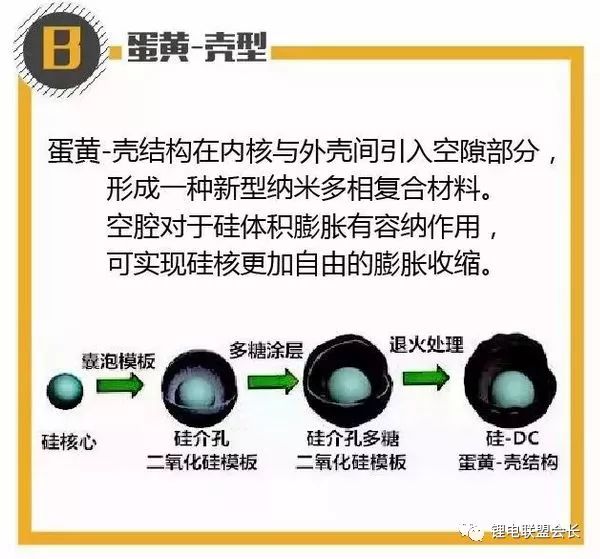The carbonaceous anode material has a small volume change during charge and discharge, and has good cycle stability energy, and the carbonaceous anode material itself is a mixed conductor of ions and electrons; in addition, silicon and carbon have similar chemical properties, and the two can be tightly combined. Therefore, carbon is often used as the preferred substrate for compounding with silicon.
In the Si/C composite system, Si particles act as active materials to provide lithium storage capacity; C can buffer the volume change of silicon negative electrode during charge and discharge, improve the conductivity of Si material, and avoid the charge of Si particles. Agglomeration occurs in the discharge cycle. Therefore, Si/C composites combine the advantages of both, exhibiting high specific capacity and long cycle life, and are expected to replace graphite as a new generation of lithium ion battery anode materials.
Starting from the structure of the silicon-carbon composite material, the currently studied silicon-carbon composite material can be divided into a cladding structure and an embedded structure. Among them, the cladding structure is coated with a carbon layer on the surface of the active material silicon to alleviate the volume effect of the silicon and enhance its conductivity. According to the coating structure and the morphology of the silicon particles, the coating structure can be classified into a core-shell type, an egg yolk-shell type, and a porous type.
Egg yolk-shell
The egg yolk-shell structure is a novel nano-phase composite material formed on the basis of the core-shell structure by introducing a void portion between the inner core and the outer shell by a certain technical means. The egg yolk-shell silicon/carbon composite exhibits a special Si@void@C shell configuration, which not only has the advantages of ordinary core-shell structure, but also its cavity has a function of accommodating silicon volume expansion, and can realize silicon. The core is more free to expand and contract, thus ensuring the stability of the overall structure of the material during charge and discharge, which is conducive to the production of a stable solid electrolyte (SEI) membrane.
Zhou et al. used a sol-gel method to coat a layer of SiO2 on the surface of silicon nanoparticles, pyrolytic carbon coating with sucrose as carbon source, and etched SiO2 with HF to obtain an egg yolk-shell composite (Si@ Void@C), wherein the active material silicon mass fraction is 28.54%. Compared with silicon nanoparticles and hollow carbon, Si@void@C has better cycle stability, the first specific capacity is 813.9 mA·h/g, and the capacity is maintained at 500 mA·h/g after 40 cycles.
Tao et al. also prepared a stable Si@void@C composite material by a similar method, and the specific capacity after cycling 100 times was 780 mA·h/g. The optimization of the carbon loading found that the specific capacity (780 mA·h/g) when the carbon loading was 63% in the composite was higher than the specific capacity (690 mA·h/g) when the carbon loading was 72%. This indicates that in order to achieve the maximum capacity of the Si@void@C composite, an in-depth optimization of the egg yolk-shell structure is required.
Liu et al. synthesized egg yolk-shell composites (Si@void@C) using polydopamine as a carbon source. In this structure, a sufficient space is reserved between the silicon core and the thin carbon layer, so that the silicon does not damage the carbon shell during the lithiation expansion, so that the surface of the composite can form a stable SEI film.
The Si@void@C has a reversible capacity of up to 2800 mA·h/g at a current density of 0.1 C, a capacity retention of 74% after 1000 cycles, and a Coulomb efficiency of 99.84%.
Recently, researchers have introduced the multi-shell concept into the silicon carbon egg yolk-shell structure design to enhance the mechanical properties of the carbon layer and improve the material's ability to resist silicon volume expansion stress.
Sun et al. prepared Si@void@SiO2 material by vesicle template method, and coated polysaccharide on the inner side of porous SiO2 shell, and pyrolyzed under high temperature to obtain Si@void@C@SiO2@C, which was etched by HF. After removing SiO2, an egg yolk-shell composite (Si@DC) having a double-shell structure (Si@void@C@void@C) was obtained, as shown in FIG.

The introduction of a double carbon layer gives the material superior electrical conductivity. At a current density of 50 mA/g, Si@DC has a specific discharge capacity of 943.8 mA·h/g after 80 cycles, while silicon/single-shell (Si@SC) and pure silicon particles have a capacity of 80 cycles. Reduced to 719.8 and 115.3 mA·h/g, respectively.
Yang et al. used the Stöber method and the pyrolysis method to sequentially coat the SiO2 layer and the carbon layer on the silicon nanoparticle table, and selectively etched by HF to obtain a double-shell composite material (Si@void@SiO2@void@C).
The material exhibits excellent cycle stability. After 430 cycles at 460 mA/g current density, the capacity is maintained at 956 mA·h/g, and the capacity retention rate is as high as 83%, while the Si@C core-shell material is under the same test conditions. The capacity of the first 10 cycles was significantly attenuated, and the capacity was less than 200 mA·h/g after 430 cycles.
In this composite structure, the carbon layer can improve the conductivity, the SiO2 layer increases the material stability, and the cavity provides a buffer space for the expansion of the silicon core. At the same time, the SiO2 and carbon double-shell layer blocks the electrolyte and silicon nanoparticles, preventing the irreversible reaction between the silicon nanoparticles and the electrolyte, and plays a double-layered guarantee.
Fiber Optic Field Connector,Fiber Optic Accessory,Optical Fiber Accessories,Optical Fiber Accessory
Huizhou Fibercan Industrial Co.Ltd , https://www.fibercannetworks.com